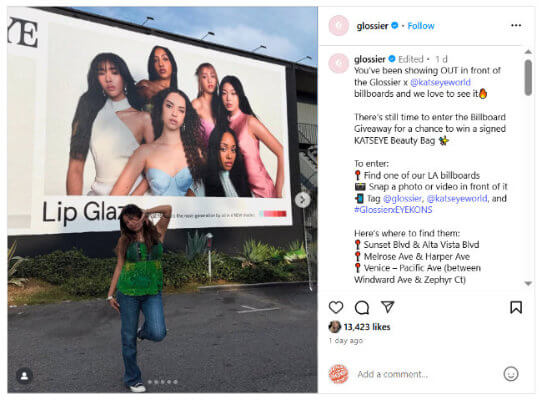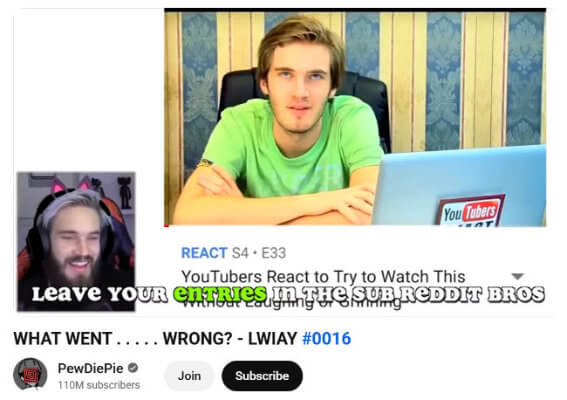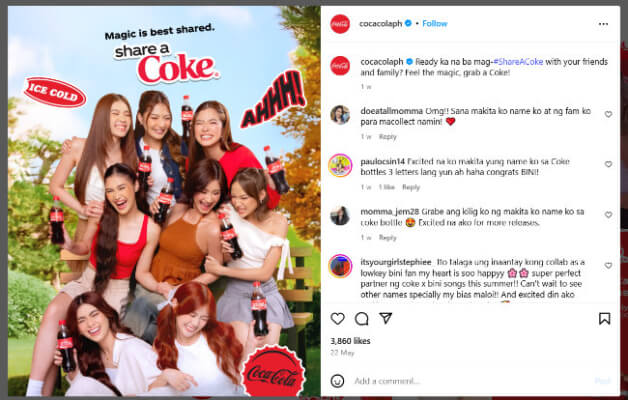Want to turn your audience into your biggest marketing asset? User-generated content, or UGC, makes it possible.
When used well, it builds trust, grows your community, and fills your content calendar with authentic posts.
In this guide, you’ll learn what UGC is, why it works, and 17 strategies to collect and share it effectively.
What is user-generated content (UGC)?
User-generated content (UGC) is any piece of content created by someone outside your brand. That could be a fan, customer, influencer, or ambassador.
It can come in many forms. Reviews, testimonials, photos, videos, comments, memes… If it features your brand but wasn’t made by you or your team, that’s user-generated content.
UGC is incredibly useful for both creators and brands. It can serve as a powerful marketing asset that can help you grow faster.
Here’s why:
- Builds trust and social proof. People trust content from their peers far more than polished brand promos.
- Expands your reach. Every UGC post shared introduces your brand to new audiences, helping to boost brand awareness.
- Boosts engagement and loyalty. When you feature someone else’s content, they feel seen and appreciated, making them more likely to stick around.
- Saves time and money. UGC helps fill your content calendar without the cost or effort of producing everything yourself. And it’s way cheaper than other paid marketing tactics.
- Makes your brand feel human. Authentic, relatable content from real people helps to humanize your brand much more effectively than ‘faceless’ promotional content.
- Drives conversions. Companies that use UGC in their marketing strategy achieve 4.5% more conversions than those that don’t.
15+ UGC strategies for creators
Now we’re all clear on what UGC is and why it’s useful, let’s look at some proven strategies and tips you can use to leverage it to grow your brand.
1. Create a branded hashtag
Set up a unique branded hashtag for fans to include in any content they share about you. This will make it easier for you to find user-generated content and reshare it.
Aim to keep your brand hashtag short, catchy, and memorable. It can be evergreen (you use the same hashtag for all your UGC campaigns) or campaign-specific (you create a new hashtag personalized for each UGC campaign).
Example: Apple’s #ShotOniPhone is a great example of how to execute a brand hashtag campaign effectively.

The brand encouraged iPhone users to share their best photos and videos using the hashtag. Apple then curates those submissions and features the best ones in its global ad campaigns.
2. Run a UGC competition
Gamify your UGC campaign by making it a competition.
Ask your audience to create and share content about you using a specific hashtag or prompt, and offer a prize for the best submission.
You can set up a UGC competition using a social media contest tool like SweepWidget. It’s super easy to use and has a bunch of neat features, like interactive leaderboards and tiered rewards.
Example: One of the best-known UGC competitions is Doritos’ annual Crash the Super Bowl contest, in which users are invited to create their own Doritos ads and submit them for consideration.

The brand then selects its favorite fan-made commercial and airs it during the Super Bowl, with the creator taking home $1 million as a cash prize.
Bonus tip: Small brands and creators don’t need to be this ambitious. You don’t need to offer a million bucks as a prize to incentivize participation.
Just make the competition fun and give your fans a chance to win something they might want—it could be something as simple as a merch package, a shoutout, a gift card, or exclusive access.
3. Incentivize with giveaways
A classic way to drive UGC is to host a giveaway.
The idea is that users have to share content about your brand/product and tag it using your campaign hashtag to be entered into the giveaway draw for a chance of winning the prize.
It’s similar to a competition. The difference is that with a competition, the prize goes to the best submission (as chosen by yourself, a panel of judges, or other users), whereas with a giveaway, the winner is selected at random.
Again, I’d recommend using SweepWidget to manage your UGC giveaway. It supports 90+ entry methods across all social platforms. You can set everything up in under 15 minutes.
Example: Glossier offered users the chance to win a signed KATSEYE beauty bag as part of a giveaway launched to celebrate a brand collab.

To enter the giveaway, users had to find one of Glossier’s three billboard ads across LA, snap a selfie in front of it, and share it on Instagram. This amplified their ad reach significantly.
Related reading: 8 Social Media Giveaway Ideas + Examples You Can Use
4. Repost fan content on your socials
Show your followers you value their support by reposting fan content to your own socials (make sure to credit them when you do). You could even make it a weekly feature (e.g. #FanFriday) if you plan to share user content regularly.
Not only does reposting UGC serve as powerful social proof for you, but it also incentivizes fans to create more in the future for the chance to be featured on your social account.
Example: Taylor Swift asked her fans to post their tour outfits on social media with the hashtag #TSTheErasTour or submit them on her website. Then, she reposted her favorites.
Bonus tip: I’d recommend using a social media scheduling tool to make it easier to repost your own fan content at scale.
Related reading: How to Repost on Instagram & How to Repost on TikTok
5. React to fan submissions
Don’t just repost UGC. React to it. This makes fans feel seen and encourages more submissions.
For instance, you could film your reaction to comments on your content or social media posts about you, or duet or stitch fan videos.
Example: YouTuber PewDiePie would post one YouTube video each week reacting to posts his fans had shared on his subreddit as part of his weekly ‘LWIAY (last week I asked you…)’ series.

Those videos were a hit, racking up millions of views and encouraging thousands of people to post content for him to react to.
6. Display UGC on your website
Feature user-generated content on your website as social proof. This could include product pages and landing pages.
There are tools that can automate this. For example, Gleam’s Galleries feature can auto-pull UGC from social media via hashtags and @mentions and display them in a responsive gallery on your website. This works particularly well if you’re running photo competitions.
Aside from your website, you can also repurpose UGC for other brand channels. Emails, social media accounts, and so on. This will help to build trust and credibility.
7. Turn UGC into ads
UGC makes great advertising content. Take the best UGC that shows your brand in a positive light and use it as social proof in your paid promotions to boost authenticity and trust.
Example: Coca-Cola’s ‘Share a Coke’ campaign. As part of a clever UGC initiative, Coke started printing names on its bottles.

People would try to find a bottle with their name on it and, when they did, they’d share their finds on social media. Coke then took those posts and turned them into ads to humanize their brand, showcasing real moments from real people enjoying their beverages.
Bonus tip: If you’re partnering with an influencer and have had them share UGC about your brand, consider boosting their post to maximize its reach.
8. Share reviews and testimonials
Reviews and testimonials are two of the most valuable forms of UGC, especially if you’re a creator who sells something to your audience (like a course or merch line).
Take glowing reviews of your products and share them everywhere: On social media, in your ads, on product pages, etc. This will help drive sales and boost conversion rates.
To get more reviews, be proactive about it and ask your customers to leave them in your post-purchase emails and at other moments of high satisfaction.
Make it easy for them to do so with QR calls, call-to-action buttons, etc. You could even offer small incentives, like discounts or entry into a raffle.
9. Launch a Duet or Stitch challenge
Encourage followers to Duet or Stitch your video on TikTok and add their twist. That could be a reaction, remix, or continuation. It’s a creative way to generate tons of UGC fast while having fun with your audience.
Example: Gossip Girl actor @Edwestwick asked viewers on TikTok to stitch his video to ‘tell me you’ve watched Gossip Girl without actually telling me you’ve watched Gossip Girl’ as a way to promote the show.

It was a huge success, racking up 32+ million views, 290k comments, and inspiring thousands of TikTok users to stitch their reactions.
10. Start a viral trend
Start a simple, repeatable trend that fans can join in on. For example, a dance or physical challenge tied to your brand. If it goes viral, it can spark massive UGC.
Example: YouTube star David Dobrik launched the ‘Chipotle Lid Flip’ challenge to promote his brand partner, Chipotle.
It encouraged other users to record themselves flipping the lid off a Chipotle bowl in creative ways, and it went insanely viral, generating tons of UGC videos for Chipotle and a huge buzz around the brand.
11. Find untagged UGC with social listening
Not all UGC is tagged. Sometimes, fans will post about you without tagging you or using your brand hashtag.
Use social media monitoring tools like Brand24 to uncover these hidden gems as soon as they’re posted, so you can engage with and reshare them.
You can set up alerts to track keywords and brand terms, and get notified about important conversations as soon as they happen, so you can jump straight into the conversation.
Related reading: Brand24 Review: Social Listening Made Easy?
12. Tap into community-driven storytelling
Give your followers a chance to tell their story about their relationship with your brand.
For instance, you could ask fans to share what your content means to them, how it’s impacted their life, or why they’re part of your world.
This kind of heartfelt UGC builds deep emotional connections, strengthening community ties and boosting loyalty.
Example: YouTube channel Good Mythical Morning once invited fans to share what the show meant to them.

The responses were heartfelt videos about how GMM helped viewers through tough times. They were featured in a milestone episode, turning fan stories into powerful, community-centered content.
13. Collaborate with influencers
Partner with influencers to kickstart your UGC campaigns. Their reach and credibility can encourage their followers to join in and get things off to a running start.
Example: Moncler launched the #MonclerBubbleUp challenge, collaborating with a network of popular influencers and celebrities, like Charli D’Amelio and Bella Poarch.

The challenge had users wrapping themselves in items resembling Moncler’s puffy coats, then transitioning into the actual product using TikTok’s editing tools.
It reached over 2.3 billion views in a matter of days and became one of the most viral hashtags of the year, showing the power of influencer partnerships for driving massive UGC.
Bonus tip: Use influencer research tools to find micro-influencers that align with your brand.
14. Start an ambassador program
Turn your biggest fans into ambassadors who regularly create UGC for your brand. Offer perks like free products, exclusive access, or early drops in exchange for content to incentivize participation.
Example: Gymshark’s Athlete program rewards ambassadors with free gear and access to Gymshark facilities, leading to a steady stream of authentic UGC content from fitness influencers.

15. Encourage fans to remix your content
Some of the most engaging UGC comes when fans remix your content in fun new ways. Think fan edits, memes, duets, and mashups.
Encouraging this creativity not only builds brand awareness but also humanizes your brand, making you more relatable.
Example: Charli D’Amelio actively engages with fan-made content. For instance, in the past, she’s liked multiple fan edits, prompting excitement among her followers. One follower shared their joy at having her edits liked by the star in this TikTok video.

These kinds of interactions deepen the creator-fan connection and motivate more fans to participate by creating their own UGC remixes.
16. Utilize employee advocacy
When most people think of UGC, they think of customer-generated content. But employee-generated content counts as UGC too.
Set up employee advocacy campaigns to encourage your team to post their own experiences and personal takes on working for your brand, or reshare UGC on their accounts to amplify its reach.
Bonus tip: You’ll need a social media management tool that offers employee advocacy features for this. Vista Social is a pretty good option.
17. Consider hiring professional UGC creators
Not all UGC has to be organic. You can hire professional UGC creators who specialize in producing authentic-looking content for brands, like testimonials, product demos, or unboxing videos.
You can find creators who know how to produce paid content that emulates the feel of traditional UGC on platforms like Billo.app, Twirl, and the TikTok Creator Marketplace.
18. Host in-person UGC moments
If you host events or have a physical space such as a store, booth, or pop-up, you could set up an eye-catching area designed specifically to encourage social sharing.
Think photo walls, branded mirrors, or selfie stations with ring lights and props. Make it easy (and tempting) for people to snap a pic, tag you in it, and share it online.
Example: Retail brands like Glossier have in-store photo spots for customers to take selfies and encourage them to share them with branded hashtags, helping to drive UGC.
Best practices for sharing UGC
Before we wrap up, let’s look at some best practices for sharing UGC.
If you’re going to repost content created by other users on your own brand channels (your website, social media accounts, ads, etc.), it’s important to make sure you stick to these rules.
Get permission
It’s good practice to always get permission before you share someone else’s content.
In some cases, you won’t need to ask for permission directly as it’s already implied.
For instance, if the creator already tagged your brand, mentioned you in the caption, or used a branded hashtag you promoted (as long as you made it clear in your branded hashtag campaign terms that you’d share user submissions), then you can usually assume they’ve given you permission already.
You also don’t usually need to get permission if you’re resharing using the platform’s built-in tools (like Instagram’s ‘Add to Story’ feature).
In most other cases, you do need to get explicit permission from the original poster.
That’s especially important if you’re reposting on a different platform than the original, you plan to use it in ads or commercial campaigns, or the content includes copyrighted material or identifiable people.
The easiest way to get permission is to simply DM the creator or comment on their post and ask if it’s okay if you share it. If you want to be super cautious, a formal contract works better.
Note: If in doubt, always contact a lawyer to be sure. In case you hadn’t guessed, I’m not a lawyer.
Credit the original creator
Always try to give credit to the original creator when you share UGC on your socials or anywhere else. This shows respect and avoids potential PR or legal issues later down the line.
The best way to give credit varies by platform. Often, it’s as easy as tagging them in your post caption, e.g., ‘Thanks to @thecreator for this awesome photo!’
You can also tag them in the post itself using native tagging features, or in the comments section. If you’re creating a video featuring UGC, you could even shout them out by saying their name in the video itself.
Don’t edit UGC
When you share someone else’s content, leave it unedited.
If you must edit it, do so in a way that respects the original creator’s voice. Don’t edit it in a way that misrepresents the original intent.
For instance, don’t crop out important context, rewrite captions to fit your own narrative, or present the content in a way that changes its meaning. That erodes trust and can lead to backlash or even legal trouble.
Vet the source before you share
Before reposting UGC, take a moment to check the original creator’s profile.
Sharing content from someone with a history of offensive, hateful, controversial behavior, or opinions that don’t align with your brand values can lead to PR fallout.
Many creators and brands have faced backlash after retweeting posts from influencers who have been later exposed for problematic views. A quick scan can save your brand from unintended and unwanted associations and help you avoid controversy.
Final thoughts
That concludes the creator’s guide to user-generated content.
Let’s recap what we’ve learned.
UGC refers to content created by users outside of your brand – like your fans or customers.
It’s useful for creators as reposting UGC can help you to build trust with your audience, strengthen your community ties, provide powerful social proof, and fill out your content pipeline.
Use the strategies we’ve looked at in this post to curate UGC at scale. Then, share the best content on your own socials and across other brand channels (like your website and ads) to make the most of it.
Disclosure: Our content is reader-supported. If you click on certain links we may make a commission.

